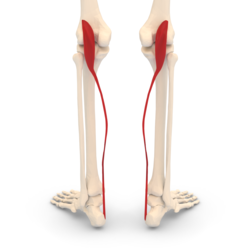| Plantaris muscle | |
|---|---|
 Plantaris muscle. Seen from behind. | |
Dissection video (1 min 23 s) | |
| Details | |
| Origin | Lateral supracondylar ridge of femur above lateral head of gastrocnemius <link issue> |
| Insertion | Tendo calcaneus (medial side, deep to gastrocnemius tendon) |
| Artery | Sural arteries |
| Nerve | Tibial nerve from anterior rami of S1-S2 |
| Actions | Plantar flexes foot and flexes knee |
| Antagonist | Tibialis anterior muscle |
| Identifiers | |
| Latin | musculus plantaris |
| TA98 | A04.7.02.049 |
| TA2 | 2663 |
| FMA | 22543 |
| Anatomical terms of muscle | |
The plantaris is one of the superficial muscles of the superficial posterior compartment of the leg, one of the fascial compartments of the leg.
It is composed of a thin muscle belly and a long thin tendon. While not as thick as the achilles tendon, the plantaris tendon (which tends to be between 30–45 centimetres (12–18 in) in length) is the longest tendon in the human body. Not including the tendon, the plantaris muscle is approximately 5–10 centimetres (2.0–3.9 in) long and is absent in 8-12% of the population. It is one of the plantar flexors in the posterior compartment of the leg, along with the gastrocnemius and soleus muscles. The plantaris is considered to have become an unimportant muscle when human ancestors switched from climbing trees to bipedalism and in anatomically modern humans it mainly acts with the gastrocnemius.[1]
- ^ Sichting, Freddy; Holowka, Nicholas B.; Ebrecht, Florian; Lieberman, Daniel E. (2020-02-26). "Evolutionary anatomy of the plantar aponeurosis in primates, including humans". Journal of Anatomy. 237 (1). Wiley: 85–104. doi:10.1111/joa.13173. ISSN 0021-8782. PMC 7309290. PMID 32103502.